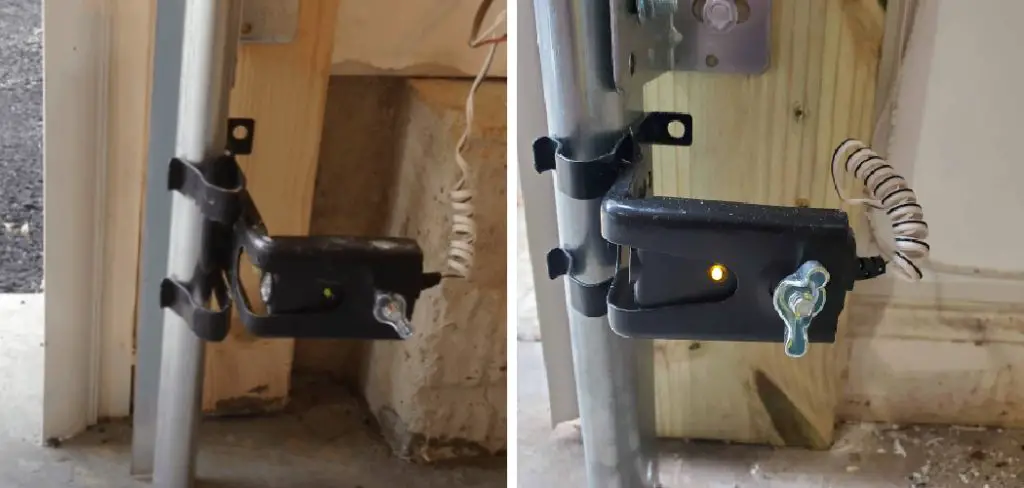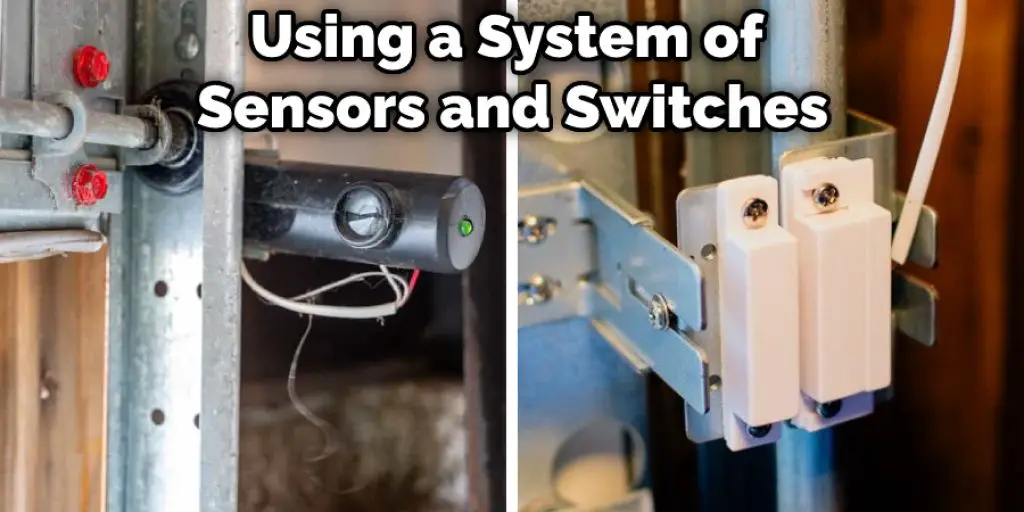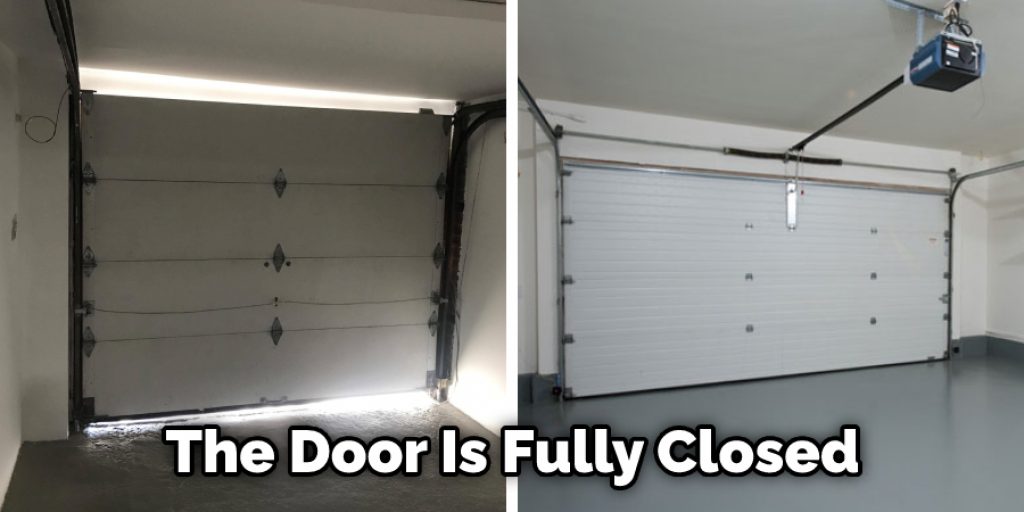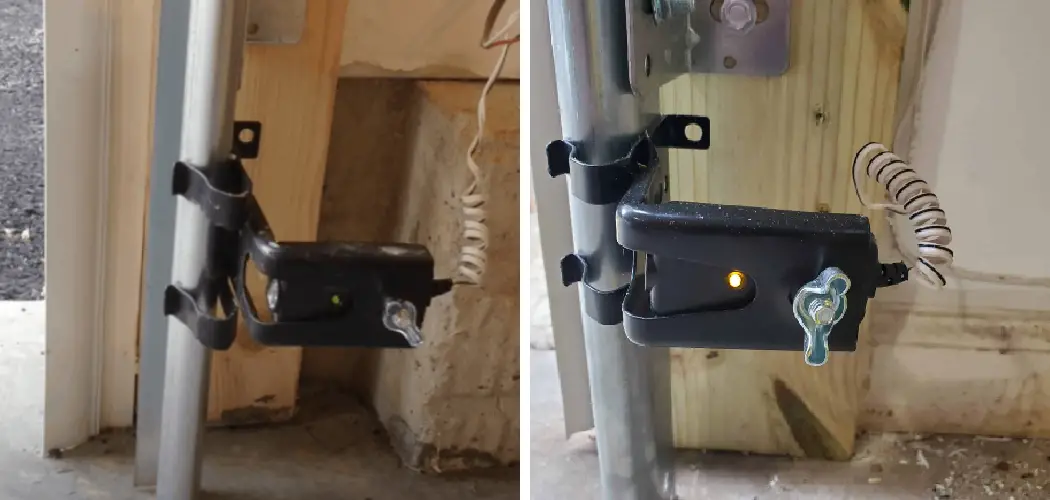Have you ever wondered how do garage door sensors work? Unfortunately, most people have no idea what goes on behind the scenes to make their garage door open and close. In this blog post, we’ll look at how these sensors work and what they do. We’ll also explore some of the different types of sensors available today. So, if you’re curious about how your garage door works, keep reading!

Summary: Garage door sensors work by sending a beam of infrared light between two units – one sending, one receiving – that are installed on either side of the garage door. If the light beam is interrupted while the door is closing, the sensor detects the obstruction and sends a signal to the motor to stop the door from closing.
What Is a Garage Door Sensors?
Garage door sensors detect when a garage door is open or closed. They are usually mounted on the wall near the door, and they consist of two parts: a transmitter and a receiver. The transmitter sends out a signal, and the receiver measures how long it takes for the signal to return. If the door is open, the signal will take longer to return. If the door is closed, the signal will return more quickly.
15 Steps on How Do Garage Door Sensors Work?
Step 1: Understand the Purpose of Garage Door Sensors
Garage door sensors, also known as photo-eye sensors or safety sensors, serve as a safety mechanism to prevent accidents and property damage. They detect obstacles in the path of a closing garage door and send a signal to the garage door opener to reverse its direction, preventing the door from closing on objects, vehicles, or people.
Step 2: Learn the Components of Garage Door Sensors
Garage door sensors consist of two primary components:
- Transmitter: This unit emits an infrared beam of light, which is invisible to the human eye.
- Receiver: This unit detects the infrared beam emitted by the transmitter.
These components are typically installed on either side of the garage door, approximately 6 inches above the ground, and aligned so that the infrared beam travels uninterrupted between them.
Step 3: Understand How the Infrared Beam Works
The transmitter sends out a continuous infrared beam toward the receiver. When the garage door is open, the beam remains unobstructed, allowing the receiver to detect it. If an object interrupts the beam, the receiver will no longer detect the infrared light, triggering a safety mechanism that prevents the door from closing.
Step 4: Learn How Garage Door Sensors Communicate with the Opener
When the receiver detects a break in the infrared beam, it sends a signal to the garage door opener’s control board. The control board processes this information and takes the appropriate action, typically reversing the direction of the garage door to prevent it from closing on the obstruction.
Step 5: Understand the Role of Limit Switches
In addition to the safety sensors, garage door openers also include limit switches that regulate the door’s movement. These switches tell the opener when to stop the door’s upward or downward motion, preventing it from traveling too far in either direction. If the limit switches are not set correctly, the door may close even when the safety sensors detect an obstruction.
Step 6: Learn About the Troubleshooting Process
Garage door sensors can sometimes malfunction or become misaligned, leading to a non-responsive garage door or one that reverses direction when no obstructions are present. In these cases, it’s essential to troubleshoot the sensors and take the necessary steps to resolve the issue.
Step 7: Check for Obstructions and Clean the Sensors
Inspect the area around the sensors for any obstructions, such as dirt, debris, or spiderwebs. Clean the sensors’ lenses with a soft cloth or a cotton swab and mild soapy water to remove any dirt or grime that may be interfering with the infrared beam.
Step 8: Check the Alignment of the Sensors
Misaligned sensors can prevent the infrared beam from reaching the receiver. Ensure that both the transmitter and receiver are securely mounted and properly aligned. Most garage door sensors have indicator lights that signal when they are correctly aligned. Consult the manufacturer’s instructions for guidance on aligning your specific sensor model.
Step 9: Test the Garage Door Sensors
To test the functionality of your garage door sensors, open the garage door and place an object in the path of the infrared beam. Press the garage door opener’s button to close the door. If the sensors are functioning correctly, the door should reverse direction when it encounters the object.
Step 10: Inspect the Wiring
If the sensors are clean and aligned but still not functioning correctly, inspect the wiring connecting the sensors to the garage door opener. Look for any signs of damage, such as frayed wires or loose connections. Repair or replace any damaged wiring to ensure proper communication between the sensors and the opener.
Step 11: Consider Replacing Faulty Sensors
If you’ve tried all of the troubleshooting steps and the garage door sensors still do not function correctly, it may be necessary to replace them. Purchase a compatible replacement sensor set from a reputable supplier or contact a professional garage door technician for assistance in selecting and installing the correct sensors for your garage door system.
Step 12: Perform Regular Maintenance on Garage Door Sensors
To ensure the continued functionality and safety of your garage door sensors, perform regular maintenance checks. Clean the sensor lenses, inspect for proper alignment, and check for any signs of wear or damage to the wiring. Address any issues promptly to maintain the safety and reliability of your garage door system.
Step 13: Understand the Role of Safety Sensors in Garage Door Safety Standards
In the United States, garage door safety sensors have been a mandatory safety feature since 1993, as required by the Consumer Product Safety Commission (CPSC) and the Underwriters Laboratories (UL). These standards aim to reduce the risk of injury or property damage due to garage door accidents. Ensure that your garage door system complies with these safety standards by maintaining functioning safety sensors.
Step 14: Educate Family Members About Garage Door Safety
Inform your family members about the importance of garage door safety and the role of safety sensors in preventing accidents. Teach them how to recognize potential issues with the sensors and how to report any problems for prompt resolution.
Step 15: Know When to Call a Professional
If you’re unsure about the functionality of your garage door sensors or if you encounter a problem that you cannot resolve, do not hesitate to call a professional garage door technician. They can diagnose and repair any issues with your garage door system, ensuring that your sensors function correctly and your garage door operates safely.
By understanding how garage door sensors work, you can maintain a safe and functional garage door system. Regular maintenance and prompt attention to any issues can help to prevent accidents and ensure the longevity of your garage door.
How Do Automatic Garage Doors Work?
Most automatic garage doors work using a system of sensors and switches. The sensors are usually located at the bottom of the door, and when something passes through the sensor’s beam of light, it sends a signal to the opener unit. This tells the opener to start or stop its operation.

There are also pressure-sensitive switches located near the bottom of the door. When the door is closed, these switches are activated and signal the opener to close the door. When the door is opened, the switches are deactivated and signal the opener to open the door.
Some garage doors have a manual release handle that can be used to manually open or close the door in a power outage or other problem.
What Are Some Reasons My Garage Door Opener May Not Work?
There are a few reasons your garage door opener may not be working. One reason is that the sensors may be out of alignment. Another reason is that there may be something blocking the sensors. Finally, the batteries in the remote may need to be replaced. Here are some other reasons:
Track Not Aligned for the Garage Door Opener
This is the number one problem people have with their garage door opener. The sensors keep the door from closing on someone or something, and they need to be in alignment for it to work properly. If they are not, the door will open and close, but it will not stay open without someone holding it. This can be a safety hazard for people and pets.
Old Age of the Garage Door Opener
Like any other machine with moving parts, garage door openers are subject to wear and tear over time. The average lifespan of a garage door opener is around 10-15 years. So if your opener is getting up there in age, it may be time to start shopping for a new one.
Bad Batteries for the Garage Door Opener
A few different things could cause your garage door not to open. One of the most common issues is a bad battery in the garage door opener. If you have checked that the power is on and still not working, the battery is likely dead.
It’s always a good idea to have a spare battery on hand if this happens. You can usually find them at your local hardware store. If you have a keyless entry, you may also want to keep a spare key somewhere close by in case you lose your remote.
Dirty or Obstructed Sensors
One common issue with garage door sensors is that they may become dirty or obstructed. If this happens, the sensors may not be able to detect that the door is fully closed, which could cause the door to close unexpectedly. Keep reading for more information about how do garage door sensors work.

Some Other Types of Sensor and How They Work
Garage door sensors are devices installed on garage doors to help prevent them from being opened when someone or something is in the way. They work by sending a signal to the opener unit when they detect an obstacle, which then prevents the door from opening.
Photo-Eye
These sensors use a beam of light to detect if anything is in the way of the door. If something interrupts the beam, the sensor will signal the opener to stop it from opening.
Shadow Sensor
Also known as an “infrared sensor,” this type of garage door sensor uses a beam of infrared light to detect if an object is in the way of the door. If the beam of light is broken, the sensor knows that there is something in the way and will not allow the door to close.
Photoelectric Sensor
A photoelectric sensor is a device that uses light to detect the presence of an object. Photoelectric sensors are often used in security applications, such as door alarms. Still, they can also be used in garage door openers to detect the presence of a person or vehicle.
The Line of Sight
Garage door sensors work by using a line of sight. When the door is closed, the sensor on the bottom of the door will send a signal to the opener. If something is blocking the line of sight between the two sensors, the opener will not close the door. Therefore, keeping pets and other objects away from the sensors is important. If the door closes on something, it can damage the sensors and keep the door from opening. If you want to know more about how do garage door sensors work, keep reading.

How Do I Determine If It’s a Problem With the Garage Door Sensor?
If you’re having trouble with your garage door, one of the first things you should check is the sensor. The sensor is what tells the door when to open and close. If there’s a problem, your garage door may not be working properly.
To determine if there’s a problem with your garage door sensor, start by visually inspecting it. If you see any damage to the sensor, or if it’s not in the correct position, that could be the problem.
If the sensor appears to be fine, the next step is to test it. For example, most garage door openers have a button you can press to test the sensors. If the sensors are working properly, the door should open and close.
If the door doesn’t open or close, or if it only opens or closes part of the way, there could be a problem with the sensor. The easiest way to test this is to bypass the sensor altogether. This can usually be done by disconnecting the sensor wire and connecting it to the opener. If the door opens and closes properly, the sensor is most likely the problem.
How Do You Repair Garage Door Opener Sensors?
The garage door opener sensors tell the opener when to stop and start. If these sensors are not working properly, your garage door opener will not function correctly. However, there are a few things that you can do to repair your garage door opener sensors.
Dirty lenses
One of the most common problems with garage door opener sensors is that the lenses get dirty. This can cause the sensors not to work properly. To clean the lenses, you will need to take the cover off the sensor and use a cloth to wipe them clean.
Out of Alignment
If the sensors are out of alignment, they will not be able to detect the opening and closing of the garage door. To fix this, you can use a level to align the sensors.
Dead Battery
One of the most common reasons for garage door opener sensors to stop working is a dead battery. If your sensors are not responding to the remote, it might be because the battery in the remote is dead. Try replacing the battery in the remote and see if that fixes the problem.
Frequently Asked Question
Why Should I Call a Professional for My Garage Door Safety Sensors?
There are a few reasons you should call a professional for your garage door safety sensors. One, it’s always best to have a professional inspect and maintain your equipment to ensure it’s in proper working order.
Two, if your sensors are not functioning properly, it could signify that something is wrong with your door and needs to be repaired. Finally, safety sensors are an important part of your garage door system and should be kept in good condition to avoid injury or damage.

Will My Garage Door Work if I Disconnect the Sensors?
If you disconnect the sensors, your garage door may not work. The sensors help the garage door opener know when the door is open or closed to operate properly. If you have a manual garage door opener, you can still open and close the door without the sensors.
Conclusion
Garage door sensors are an important part of your garage security system. By understanding how do garage door sensors work, you can ensure that they are always functioning properly and keeping your home safe.
You Can Check It Out To Heat a Garage Without Electricity
You can check it out to Trick Garage Door Sensors
I am Rick. I grew up helping my dad with his handyman service. I learned a lot from him about how to fix things, and also about how to work hard and take care of business. These days, I’m still into fixing things- only now, I’m doing it for a living.
I’m always looking for new ways to help people grow and develop. That’s why I have created this blog to share all my experience and knowledge so
that I can help people who are interested in DIY repair.

